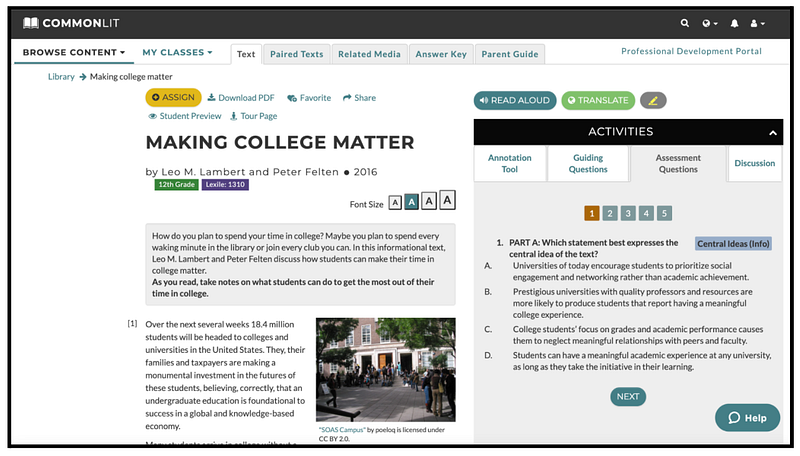These 11 engaging texts to help students think about their roles in their different communities!
As middle and high school students get older, they are figuring out their place in the world. They may have different roles in the classroom, their family, and their clubs or teams. Reading about different kinds of communities can help students envision what they want their contributions to be in their own circles and beyond.
This diverse set of texts for grades 6–12 explores the theme of community. These texts include short stories, scientific studies, informational texts, and more.
“Celebrating Cinco de Mayo” by Sanjana Chetia (6th Grade)
In this informational text, Sanjana Chetia describes the history of Cinco de Mayo and its significance to Mexican American communities today. The meaning of the holiday has evolved over the years. It started as a day marking a battle for independence and now is a day to celebrate Mexican culture. This text provides students with a great opportunity to think about how holidays and traditions foster a sense of community.
“The War of the Wall” by Toni Cade Bambara (7th Grade)
In this short story, set during the Vietnam War, the narrator is angry at a woman who is painting a wall that belongs to the neighborhood. At the end of the story, it is revealed that the woman painted the wall in memory of her cousin Jimmy Lyons, who lived in the neighborhood and was killed in Vietnam. This story can be used to start a discussion about what it means to truly belong to a community.

“More Facebook Friends, Fewer Real Ones, Says Cornell Study” by ABC News (8th Grade)
This informational text discusses a study that examined how people interact with friends online and in person. Matthew Brashears, the Cornell University sociologist who conducted the study, concluded that many people today have fewer real friends. The article discusses the similarities and differences between the kind of support people get from friends online and in person. This text provides students with the chance to reflect on the importance of different kinds of friendships in their own lives.
“Healing ‘Brick City’: A Newark Doctor Returns Home” by NPR Staff (8th Grade)
In this interview, Dr. Sampson Davis discusses his journey to become a physician and his experience helping his community. Dr. Davis knew that he wanted to come back to Newark after becoming a doctor so he could show young people that education can change a life. This text provides students with the opportunity to consider the responsibilities we have within our communities.
“Going to School as a Refugee” by Caroline Garrison (8th Grade)
In this news feature, Caroline Garrison learns about the lives of young refugees in Dallas, Texas. SB, a teenager, discusses the importance of the support system he has formed with other refugees at his school. SB shares that he seeks out other refugees because they understand what he is going through and help him build confidence. This text provides students with the opportunity to reflect on the ways friends and classmates help each other be successful.

“No Man is an Island” by John Donne (9th Grade)
In this text, English poet John Donne uses an extended metaphor to emphasize the importance of connection between people. According to Donne, everyone is part of a community and the death of any member of a community affects everyone. After reading, students can discuss the similarities and differences between Donne’s conception of community and modern society.
“Life on Reservations” by Jessica McBirney (9th Grade)
In this informational text, Jessica McBirney discusses the tragic history of Native American relocation, as well as the quality of life of tribes on reservations today. Many tribes continue to practice key parts of their cultures, even though they are no longer allowed to live on their ancestral lands. This text provides students with the opportunity to consider the obstacles Native American communities face today and the ways they continue to honor their heritage despite these challenges.
“This is Not Who We Are” by Naomi Shihab Nye (10th Grade)
In this personal essay, Naomi Shihab Nye reflects on her relationship with her Arab-American identity after 9/11. Paying tribute to her Palestian roots brings her both sadness and joy. Nye affirms the importance of choosing to be proud of her culture and honoring the innocent victims from her community. After reading, students can reflect on their own identities and the significance of the communities to which they belong.
“Political Society” by John Locke (10th Grade)
English philosopher John Locke, whose writings influenced American revolutionaries, explains the factors needed to create a political society. Individuals must cede power to the authority of the community, which impartially applies the rules and settles disputes. This text would be great for an interdisciplinary unit about community or government.
“Once Upon a Time” by Nadine Gordimer (11th Grade)
In this short story, which takes place during the end of the apartheid era in South Africa, a family living in fear tries to protect themselves from rioting and burglaries in their neighborhood. Desperate to keep their young son safe, they install a variety of security measures that ultimately lead to tragedy. This thought-provoking text provides students with the opportunity to consider the impact of isolation and division in communities.
“Making College Matter” by Leo M. Lambert and Peter Felten (12th Grade)
This informational text provides concrete suggestions for how students can get the most out of their college experience. One of the most important suggestions is to develop meaningful relationships with peers and faculty. Forming a community in college helps students learn more deeply and also helps them have fun. After reading, students can discuss ways they can form a supportive social network after high school.

Next Steps
Want to explore the theme of identity further with your students? Browse more texts about identity in the CommonLit library!
If you’re interested in learning all about CommonLit’s free digital literacy program, join one of our upcoming webinars!


